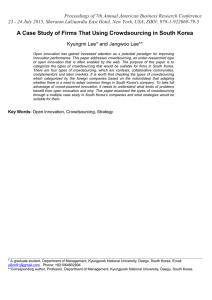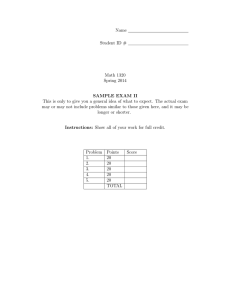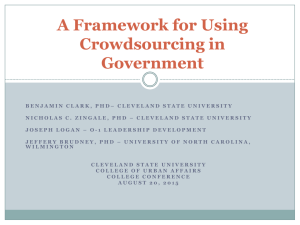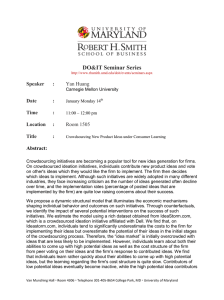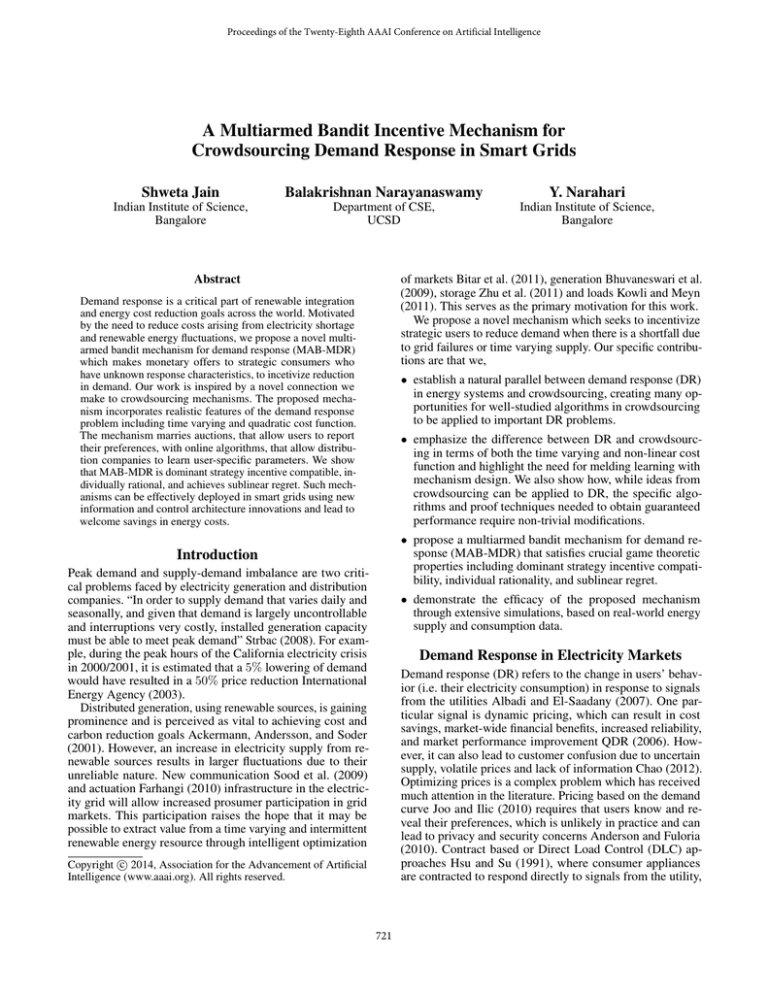
Proceedings of the Twenty-Eighth AAAI Conference on Artificial Intelligence
A Multiarmed Bandit Incentive Mechanism for
Crowdsourcing Demand Response in Smart Grids
Shweta Jain
Balakrishnan Narayanaswamy
Y. Narahari
Indian Institute of Science,
Bangalore
Department of CSE,
UCSD
Indian Institute of Science,
Bangalore
Abstract
of markets Bitar et al. (2011), generation Bhuvaneswari et al.
(2009), storage Zhu et al. (2011) and loads Kowli and Meyn
(2011). This serves as the primary motivation for this work.
We propose a novel mechanism which seeks to incentivize
strategic users to reduce demand when there is a shortfall due
to grid failures or time varying supply. Our specific contributions are that we,
Demand response is a critical part of renewable integration
and energy cost reduction goals across the world. Motivated
by the need to reduce costs arising from electricity shortage
and renewable energy fluctuations, we propose a novel multiarmed bandit mechanism for demand response (MAB-MDR)
which makes monetary offers to strategic consumers who
have unknown response characteristics, to incetivize reduction
in demand. Our work is inspired by a novel connection we
make to crowdsourcing mechanisms. The proposed mechanism incorporates realistic features of the demand response
problem including time varying and quadratic cost function.
The mechanism marries auctions, that allow users to report
their preferences, with online algorithms, that allow distribution companies to learn user-specific parameters. We show
that MAB-MDR is dominant strategy incentive compatible, individually rational, and achieves sublinear regret. Such mechanisms can be effectively deployed in smart grids using new
information and control architecture innovations and lead to
welcome savings in energy costs.
• establish a natural parallel between demand response (DR)
in energy systems and crowdsourcing, creating many opportunities for well-studied algorithms in crowdsourcing
to be applied to important DR problems.
• emphasize the difference between DR and crowdsourcing in terms of both the time varying and non-linear cost
function and highlight the need for melding learning with
mechanism design. We also show how, while ideas from
crowdsourcing can be applied to DR, the specific algorithms and proof techniques needed to obtain guaranteed
performance require non-trivial modifications.
• propose a multiarmed bandit mechanism for demand response (MAB-MDR) that satisfies crucial game theoretic
properties including dominant strategy incentive compatibility, individual rationality, and sublinear regret.
Introduction
Peak demand and supply-demand imbalance are two critical problems faced by electricity generation and distribution
companies. “In order to supply demand that varies daily and
seasonally, and given that demand is largely uncontrollable
and interruptions very costly, installed generation capacity
must be able to meet peak demand” Strbac (2008). For example, during the peak hours of the California electricity crisis
in 2000/2001, it is estimated that a 5% lowering of demand
would have resulted in a 50% price reduction International
Energy Agency (2003).
Distributed generation, using renewable sources, is gaining
prominence and is perceived as vital to achieving cost and
carbon reduction goals Ackermann, Andersson, and Soder
(2001). However, an increase in electricity supply from renewable sources results in larger fluctuations due to their
unreliable nature. New communication Sood et al. (2009)
and actuation Farhangi (2010) infrastructure in the electricity grid will allow increased prosumer participation in grid
markets. This participation raises the hope that it may be
possible to extract value from a time varying and intermittent
renewable energy resource through intelligent optimization
• demonstrate the efficacy of the proposed mechanism
through extensive simulations, based on real-world energy
supply and consumption data.
Demand Response in Electricity Markets
Demand response (DR) refers to the change in users’ behavior (i.e. their electricity consumption) in response to signals
from the utilities Albadi and El-Saadany (2007). One particular signal is dynamic pricing, which can result in cost
savings, market-wide financial benefits, increased reliability,
and market performance improvement QDR (2006). However, it can also lead to customer confusion due to uncertain
supply, volatile prices and lack of information Chao (2012).
Optimizing prices is a complex problem which has received
much attention in the literature. Pricing based on the demand
curve Joo and Ilic (2010) requires that users know and reveal their preferences, which is unlikely in practice and can
lead to privacy and security concerns Anderson and Fuloria
(2010). Contract based or Direct Load Control (DLC) approaches Hsu and Su (1991), where consumer appliances
are contracted to respond directly to signals from the utility,
c 2014, Association for the Advancement of Artificial
Copyright Intelligence (www.aaai.org). All rights reserved.
721
certain cluster i implies giving monetary incentives to all ni
consumers that belong to the cluster. Note that this assumption on its own is not limiting, since cluster size can be as
small as required, though we shall see that many small clusters will result in worse bounds. We associate three quantities
with each cluster, the
require that consumers are willing to give up control of their
consumption.
An important point to note is that legacy entails that
providers have an ‘obligation to serve’, i.e. providers cannot
deny to users access to electricity, but can only incentivize
them to voluntarily reduce or defer consumption. In simpler
terms, it is preferable if providers use carrots as opposed to
sticks, and this is the philosophy we take in our work. A
recent body of work at the intersection of computer science
and economics has established that general incentives (as
opposed to just pricing) are a powerful way to allocate scarce
resources. In our work, we build on these insights and propose
a multiarmed bandit mechanism for the problem of making
offers to the consumers to reduce their consumption so as
to compensate for shortage of electricity when renewable
generation does not meet expectations. These mechanisms
do not have the drawbacks discussed above. In particular, we
show that our mechanism is dominant strategy incentive compatible (i.e. encourages consumers to report their true cost
per unit reduction), individually rational (i.e. gives each consumer positive utility for accepting the offer), and achieves a
sublinear regret of O(T 2/3 ) where T is the number of time
steps for which the mechanism runs.
• price at which consumers are willing to reduce consumption by one unit (cost per unit reduction (CPR)). CPR is
private information of the consumers that depends on their
utility function.
• probability of accepting the offer (acceptance rate (AR))
if the offer price is greater than the CPR. Consumer may
not accept the offer even if the offer price exceeds the
CPR. The reasons for this include (a) an inflexible all or
nothing requirement of the consumer; (b) sudden lack of
requirement for the power; (c) availability of the consumer
(is he at home?). Consumers have no control on these
factors and thus, AR is independent of the offer prices and
other consumers. AR is unknown to the consumer as well
as the distribution company.
• number of consumers, which is publicly known.
These correspond to private information that require incentives for truthful revelation, stochastic information that must
be learned and common knowledge. We are interested in the
design of MAB mechanisms that account for all three, and
we see DR as a specific instantiate of this general problem
(for more details see the Related Work on MAB problems).
Clusters of consumer types are formed such that all the
consumers in same cluster share the same CPR and AR, based
on past bids and response behavior. For each cluster i, denote
its CPR by ci ∈ [cmin , cmax ], AR by λi ∈ [0, 1] and number
of consumers by ni . The main challenge in computing the
optimal offers involves learning ARs efficiently and eliciting
CPRs truthfully. CPRs can be elicited by either
Modeling Offers for Demand Response
We consider a model where offers (monetary rewards) are
made to the consumers in exchange for reducing the consumption. For simplicity of exposition, we assume consumers are
asked to reduce the same amount of consumption. Offers are
made at the starting of each time slot. T denotes total number
of slots.
Let d¯ = {d¯1 , d¯2 , . . . , d¯T } represent the expected total demand profile of all the consumers in each time slot. This
is learned over time by the distribution company based on
historical consumption. To meet demand, renewable energy
sources are available to the distribution company in addition
to the option of buying electricity from the market. Renewable supply is stochastic and depends on the environmental
conditions. Let r̄ = {r̄1 , r̄2 , . . . , r̄T } represent the expected
amount of energy generated from renewable resources, which
is a known quantity. The distribution company then plans to
buy d¯ − r̄ units of electricity in the day ahead market Harris
(2006).
The actual amount of energy generated by the renewable
resource (rt ) is revealed only at the start of a slot t. The
shortage of electricity at any slot t is thus given by et =
r̄t − rt which has to be generated by expensive fast ramping
generators or at expensive spot market prices. The question
we ask in this work is how can the distribution company
reduce costs by incentivizing the consumers to reduce their
consumption, while learning about their uncertain response
characteristics ?
We model consumers using n clusters, where all ni consumers of a cluster i have the same utilities for electricity and
the same response characteristics to offers (described more
carefully below). These clusters correspond, for example,
to industrial consumers of a certain industry, or may be the
result of other forms of consumer segmentation. For more
detailed justification see Ardakanian, Keshav, and Rosenberg
(2011). For simplicity we assume that making an offer to a
• Posted Offer Mechanisms: Offer the same price to every
consumer and set the price based on the user behavior.
• Auction Mechanisms: Design a mechanism to elicit true
CPR from the consumers by asking for bids.
Posted offer mechanisms are easier for the consumer as he
does not need to compute his entire utility function and only
needs to evaluate offered price to decide whether or not to
accept the offer. Auctions are easier for the distribution company. To illustrate the power of crowdsourcing mechanisms,
we use auctions to elicit CPR truthfully, while learning ARs
to design price offers optimally.
Our auction mechanism proceeds as follows: The distribution company asks each cluster to report their CPR bids.
Based on the learned ARs, and CPR bids, offer price to a
particular cluster i is decided. If the offer price is greater than
true CPR of the consumer, then he accepts the offer with
probability λi (since he gets positive utility) and distribution company pays him the offer price. ARs and CPRs are
considered static and thus do not change with time.
There is a close connection between making offers to the
consumers in demand response and giving tasks to the workers in crowdsourcing. In the next section, we expand on and
exploit this parallel between and show how algorithms from
722
Crowdsourcing
Demand Response (DR)
Notation
Description
Workers
Requester
Tasks
Price of a task
Capability or Reliability
Willingness to do task
Linear reward function
Homogeneous tasks
Consumers
Distribution company
Offers to reduce consumption
Offer Price
Acceptance rate (AR)
Cost per unit reduction (CPR)
Quadratic reward function
Time varying offers
N
n
T
ci , ĉi
λi
ni
n+ , n −
et
ati ∈ {0, 1}
pti
τ
Set of all clusters
Number of clusters
Total number of rounds
Actual and reported CPR of consumer i
AR of all consumers in cluster i
Number of consumers in cluster i
maxi ni and mini ni
Shortage of electricity at time t
Allocation of cluster i at time t
Payment for a consumer in cluster i
Number of exploration rounds
Table 1: Parallel between Crowdsourcing and Demand Response
Table 2: Notation used
crowdsourcing can be modified to design efficient mechanisms for demand response.
such as ours. Thus, while borrowing intuition from the crowdsourcing literature, we present new algorithms and bounds
that extend the state-of-the-art in MAB mechanisms.
A Parallel with Crowdsourcing
Jeff Howe offers the following definition of crowdsourcing:
“Crowdsourcing is the act of taking a job traditionally performed by a designated agent (usually an employee) and
outsourcing it to an undefined, generally large group of people in the form of an open call” Howe. The designated agent
is often called the requester, while people working on the
task are called crowd workers. The requester needs to assign
the task to these workers with unknown capability and willingness to complete the task based on the goals to achieve.
Table 1 precisely demonstrates this parallel between crowdsourcing and demand response. This opens up the possibility
of using intuition from techniques for crowdsourcing for DR.
There is a vast body of literature available in crowdsourcing
with various models, we point out some of the more relevant
ones to show how objectives in crowdsourcing and demand
response relate. Tran-Thanh et al. Tran-Thanh et al. (2012)
present a model to assign the task to the workers with highest
capability while having a budget constraint on the total cost
of giving tasks. In DR, this involves making offers to the consumers having highest AR where the distribution company
has a certain budget. In other work, tasks are given adaptively
to the workers until a certain accuracy is achieved Abraham
et al. (2013). In DR, one can make the offers to the consumers
by asking sequentially to reduce their consumption until a
certain amount of reduction is achieved. Another line of work
involves designing a posted price mechanism where workers having homogeneous quality arrive online Babaioff et al.
(2012); Singla and Krause (2013). In our work here, we only
look at auction mechanisms and do not explore this direction,
but leave it for (very relevant) future work.
While the above parallels suggest that one can directly
borrow ideas from crowdsourcing, there are certain unique
features of the DR problem that need to be accounted for.
Making offers to consumers having the highest AR is not
optimal as offers should also depend on the (time varying)
shortage of electricity distribution company faces. In addition, the objectives in crowdsourcing (maximizing accuracy)
are very different from DR. While in crowdsourcing a linear
reward is usually considered, in DR, the reward function is
generally quadratic and thus requires non-trivial extensions
to some of the existing MAB algorithms. Moreover, while
our work considers learning ARs and eliciting CPRs simultaneously, no existing work in crowdsourcing has considered
both learning qualities and eliciting true costs in a setting
Utility Model
The notation table is given in Table 2. Denote the CPR
bid profile by ĉ = {ĉ1 , ĉ2 , . . . , ĉn }. The mechanism
M = (A(ĉ), P(ĉ)) consists of (1) an allocation rule, A =
{A1 , A2 , . . . , AT } where each At = {at1 , at2 , . . . , atn } is the
vector of zeros and ones (deterministic mechanism), and
(2) a payment rule P = {P 1 , P 2 , . . . , P T } where each
P t = {pt1 , pt2 , . . . , ptn } represents the offer price. If offer
is not made to the cluster i i.e. ati = 0 then the payment pti
is zero. If ati = 1 then all the P
consumers in type i are given
the offers at slot t, whereas, i ati = 0 means offer is not
given at all. At any time slot,
P offers are made to a single
type of consumers, i.e., ∀t, i ati ≤ 1. Note that the allocation rule and the payment rule corresponding to any time
slot always depend on the bid profile ĉ, but for brevity of
notation, we do not explicitly mention this dependence. Let
N = {1, 2, . . . , n} denote the set of all types of consumers.
The expected value of each consumer in type i is given by
−λi ci as an offer is accepted with probability λi . The expected utility of any consumer in type i at any slot t from
mechanism (A, P) is given by:
E[ui (At (ĉi , ĉ−i ), ci )] = λi (−ati ci + pti )
ĉ−i is the bid profile of consumers in types other than i.
For the distribution company,
P the expected valuation at
time t is given by R − (et − i ati ni λi )2 , where R is the
base utility for the distribution company, et is the shortage
and ni λi is the expected number of reduction units from
consumer type i. Thus, the second term denotes the cost of
procuring electricity which is usually quadratic Harris (2006).
The net utility of the distribution company is:
E[uC (At (ĉi , ĉ−i ), ci )] = R − (et −
X
ati ni λi )2 −
i
X
ni λi pti
i
We emphasize that the generality of our mechanism does
allow more complex models. The expected social welfare
(sum of the expected valuations) from mechanism (A, P) is:
W (A) = R −
T
X
t=1
(et −
X
i
ati ni λi )2 −
T X
X
t=1
ati λi ni ci (1)
i
We now define some of the desirable properties that a mechanism M = (A, P) should satisfy:
723
Definition 1 Allocative Efficiency (AE): An allocation rule
A is said to be allocatively efficient if it maximizes the social
welfare. Formally, A is allocatively efficient if:
MAB mechanisms to the reverse setting while accounting for
the quadratic reward.
We consider social welfare maximization since electricity
is a socially important good and it is natural to design mechanisms that maximize a measure of social utility. However,
maximizing the welfare of the company or its revenue can be
similarly studied.
A ∈ arg max W (A)
A
Definition 2 Dominant Strategy Incentive Compatibility
(DSIC): Mechanism M is said to be DSIC if truth telling
is a dominant strategy for all the types of consumers. Formally, ∀i ∈ N , ĉ−i and ĉi , we have,
T
X
pti (ci , ĉ−i ) − ci ati (ci , ĉ−i ) ≥
t=1
T
X
Social Welfare Regret
The Social welfare regret of a mechanism is defined as the
difference between the maximum social welfare achieved if
ARs are known by any mechanism and the expected social
welfare achieved when ARs are unknown. Formally, social
welfare regret of a mechanism (A, P) is:
pti (ĉi , ĉ−i ) − ci ati (ĉi , ĉ−i )
t=1
Definition 3 Individual Rationality (IR): Mechanism M is
said to be IR for a consumer if participating in mechanism
always gives him positive utility. Formally,
−ĉi ati (ĉi , c−i ) + pti (ĉi , c−i ) ≥ 0 ∀t ∀i ∈ N , ∀ĉi and ∀c−i
R(A) =
T
X
ati ni λi (λi ni + ci − 2et )
t=1
−
At each slot t, distribution company observes the shortage
et , and makes an offer to a consumer type which maximizes
the social welfare given by Equation (1) and thus involves
solving the following optimization problem:
T
X
t=1
min(min ni λi (λi ni + ci − 2et ), 0)
i
Our goal is to design an algorithm that achieves sublinear
regret (i.e. regret that goes asymptotically to 0 as T goes to
infinity) and satisfies the properties in Definitions 1, 2 and 3.
min(min λi ni (λi ni − 2et + ci ), 0)
i
MAB-MDR: A Novel Exploration-Separated
Mechanism
The outer minimum ensures that offers are made only if there
is an increase in social welfare. Since the response behavior of the consumers is unknown, the optimization problem
cannot be solved directly, our proposed strategy involves
learning ARs and eliciting CPRs. The distribution company
will have to both explore (make offers to consumers so as
to learn their AR) and exploit (make offers to the optimal
consumer with best capability so far). Multiarmed bandit
(MAB) mechanisms offer a natural solution.
Since ARs are unknown, we cannot apply a Vickery-ClarkeGroves (VCG) mechanism Narahari (2014) to elicit CPRs
truthfully Babaioff, Sharma, and Slivkins (2009); Devanur
and Kakade (2009). Multiarmed Bandit mechanisms provide
a powerful alternative. Existing MAB algorithms require reward functions to be monotone in terms of unknown qualities
Auer et al. (2003); Chen, Wang, and Yuan (2013) but monotonicity condition is violated in our quadratic case. Thus,
traditional MAB algorithms and analysis do not apply. In
this section, we propose a novel exploration separated mechanism provided in Algorithm 1 that satisfies all the desired
properties mentioned in Definitions 1, 2 and 3 with unknown
ARs and strategically revealed CPRs.
The proposed mechanism is exploration separated where,
the mechanism learns the ARs of all the consumer types by
giving the maximum offer price for τ (given in Corollary 1)
number of rounds in round robin fashion. Each consumer of
type i, accepts the offer with probability λi , independently
of other consumers in the same type. Thus, ni independent
samples are generated by making offers to ith types and
these can be used to learn the AR λi . Let λ̂i represent the
sample mean of λi after exploration phase. After τ rounds are
completed, upper confidence bound λ̂+
i and lower confidence
bound λ̂−
are
computed
using
Hoeffding’s
inequality. These
i
are bounds for the true ARs.
For this mechanism, Theorem 2 shows that the mechanism
is DSIC. As a result, any consumer in a particular cluster
can be asked to bid his CPR (which will be truthful and
hence same for all the consumers). After the exploration
phase, ARs are not updated in the exploitation phase. This
ensures incentive compatibility. In each round the type that
maximizes the social welfare with respect to the bounds on
ARs is chosen.
Related Work on MAB Problems
The mechanism design problem we study can be considered an extension of multiarmed bandit problems where rewards are stochastic. A recent survey by Bubeck and Bianchi
Bubeck and Cesa-Bianchi (2012) compiles several variations.
The most popular algorithm, Upper Confidence Bound (UCB)
was proposed by Peter Auer et al. Auer, Cesa-Bianchi, and
Fischer (2002). Our mechanism is exploration separated, and
as a result, is also related to work on mechanisms in the
probably approximately correct (PAC) setting proposed by
Even-Dar et al. Even-Dar, Mannor, and Mansour (2006) and
Kalyanakrishnan et al. Kalyanakrishnan and Stone (2010).
These algorithms are specific to linear reward functions and
do not consider quadratic reward functions which is the focus
of our work. Our work is also related to contextual multiarmed bandits when electricity shortage is considered to
be the context. However, existing algorithms Langford and
Zhang (2007); Lu, Pál, and Pál (2010) cannot be applied
directly due to strategic nature of the consumers.
MAB mechanisms constitute a more recent direction of
research, and have been explored mostly for sponsored search
auctions Babaioff, Kleinberg, and Slivkins (2010); Babaioff,
Sharma, and Slivkins (2009); Devanur and Kakade (2009);
Gatti, Lazaric, and Trovò (2012) where the reward function
is again linear and is a forward auction setting. We extend
724
Lemma 1 shows that MAB-MDR offers a price that is greater
than the CPR bid of the consumer to whom offer is made
and thus he derives positive utility (Theorem 1). Theorem 2
shows that it is always in the best interest of consumers to
bid their true CPRs. We then provide bounds on the expected
regret in Theorem 3.
Algorithm 1: MAB-MDR
Input: CPR bids, {ĉ1 , ĉ2 , . . . ĉn }, Number of
exploration steps τ , confidence parameter µ
Output: Sequence of allocations A1 , A2 , . . . AT and
payments P 1 , P 2 , . . . , P T
1 (Exploration Rounds) for t ← 1 to τ do
2
Make offers to all consumers in type i = ((t − 1)
mod n) + 1, ati = 1, atj = 0 ∀j ∈ N \ i
3
Make a payment pti = cmax to consumer in type i if
he accepts the offer.
4
∀i, Update λ̂i , λ̂+
i = min(λ̂i +
λ̂−
i = max(λ̂i −
5
6
7
8
9
10
11
q
q
Lemma 1 The offer price is greater than CPR bid for the
consumer to whom offer is made.
−
ni λ̂+
i (ni λ̂i
=⇒ ĉi ≤
n
ln( µ2 ), 1),
2τ ni
13
14
15
16
2
2
Theorem 2 MAB-MDR is DSIC.
Proof: We will show that ∀t, ∀i ∈ N , ∀ĉ−i and ∀ĉi ,
pti (ci , ĉ−i ) − ci ati (ci , ĉ−i ) ≥ pti (ĉi , ĉ−i ) − ci ati (ĉi , ĉ−i )
type i),
In exploration steps, fixed offers (cmax ) are made irrespective
of the bids. Thus, the condition is trivially satisfied. For any
exploitation round t,
• Case 1: ci > ĉi =⇒ ati (ci , ĉ−i ) ≤ ati (ĉi , ĉ−i )
If ati (ci , ĉ−i ) = ati (ĉi , ĉ−i ), then above condition is
trivially satisfied as the payments does not depend on
the bid of ith consumer. W.L.O.G., 0 = ati (ci , ĉ−i ) <
ati (ĉi , ĉ−i ) = 1 This implies ∀j 6= i
pti =
+
−
+
−
nj λ̂ (nj λ̂ +ĉj −2et )−ni λ̂ (ni λ̂ −2et )
j
j
i
i
min(
, cmax )
+
λ̂ ni
i
12
+ ĉj − 2et ), 0)
Proof: Follows from Lemma 1
(Exploitation rounds) for t ← τ + 1 to T do
−
t
i = arg min ni λ̂+
i (ni λ̂i + ĉi − 2e )
if
−
+ ĉi − 2et ) ≤ min(nj λ̂+
j (nj λ̂j
t
pi (ĉi , ĉ−i ) (Rearranging Terms)
Theorem 1 MAB-MDR is IR for all the consumers.
n
ln( µ2 ), 0)
2τ ni
i
t
(ni λ̂−
i + ĉi − 2e ) ≤ 0 then
t
ai = 1 (Make offers to all consumers in
atj = 0 ∀j ∈ N \ i
−
t
j = arg min nj λ̂+
j (nj λ̂j + ĉj − 2e )
j∈N \i
t
if (nj λ̂−
j + ĉj − 2e ) ≤ 0 then
W.L.O.G, pti (ĉi , ĉ−i ) < cmax . ∀j 6= i, we have,
Proof:
else
t
pti = min(−(ni λ̂−
i − 2e ), cmax )
Make payment pti to consumer in type i if he
accepts the offer.
else
atj = 0 ∀j ∈ N (Make no offer at all)
−
t
+
−
t
ni λ̂+
i (ni λ̂i + ci − 2e ) ≥ min(nj λ̂j (nj λ̂j + ĉj − 2e ), 0)
−
t
+
−
t
ni λ̂+
i (ni λ̂i + ĉi − 2e ) ≤ min(nj λ̂j (nj λ̂j + ĉj − 2e ), 0)
=⇒ −ci + pti (ĉi , ĉ−i ) ≤ 0
• Case 2: ci < ĉi
ati (ci , ĉ−i ) ≥ ati (ĉi , ĉ−i ) =⇒ 1 = ati (ci , ĉ−i ) >
ati (ĉi , ĉ−i ) = 0. Thus, −ci + pti (ci , ĉ−i ) ≥ 0 (Lemma 1)
2
Let ∆t = max λi ni (λi ni −2et +ci )−min λi ni (λi ni −2et +
i
i q
ci ), n+ = max ni , n− = min ni and = 2τnn− ln( µ2 ).
In the simpler linear cost model, consumers with the highest upper confidence bound are selected, but since the costs
are quadratic in terms of AR in our model, the consumers
have to be selected more carefully. In particular, our mechanism uses lower confidence bounds. Offers are only made if
consumers in a type generate higher expected social welfare
compared to the case where no offer is made at all (ensured
by step 7). Finally, the offer price is paid to each consumer
if he accepts the offer. Offer prices are set such that it is
truthful for every type of consumers to report true CPRs; at
the same time, the mechanism results in positive utility to
every consumer.
Note: CPR and AR of all the consumers are assumed to
be same for all the slots. Otherwise, multiple instances of the
mechanism can be run for each slot j and (for example) for
weekdays and weekends.
i
i
Lemma 2 Expected social welfare regret (E[rt ]) at any time
slot t in the exploitation round is bounded by:
(1 − 2µ)n+ (max((n+ +
2et
), 2n+ )) + 2µ∆t
n+
Proof: The social welfare regret at time t if type i 6= i∗ is
selected where i∗ is the optimal type is given by:
rt = λi ni (λi ni − 2et + ci ) − λi∗ ni∗ (λi∗ ni∗ − 2et + ci∗ )
By Hoeffding’s inequality, with probability at least (1 − 2µ),
+
−
+
λ̂−
i ≤ λi ≤ λ̂i and λ̂i∗ ≤ λi∗ ≤ λ̂i∗
Analysis of MAB-MDR
also, λ̂+
i
In this section, we provide theoretical guarantees for MABMDR. Our analysis is very different from that of traditional
MAB setting, as picking a cluster with highest upper confidence bound (UCB) is non-trivial with quadratic costs.
− λi ≤ 2 and λi −
λ̂−
i
≤ 2
(2)
(3)
• Case 1: i∗ 6= 0 =⇒ λi∗ ni∗ − 2et + ci∗ ≤ 0
−
t
+
−
t
ni∗ λ̂+
i∗ (λ̂i∗ ni∗ − 2e + ci∗ ) ≥ ni λ̂i (λ̂i ni − 2e + ci ) (4)
725
Figure 2: Effect of shortage on social welfare with/without offers with different cluster sizes. The social welfare increases
when incentives are provided to larger number of consumers
Figure 1: Effect of time on total regret. The regret follows
the O(T 2/3 ) bound, validating our analysis (Theorem 3).
1. Mean wind energy r̄ is considered as the average of wind
energy available at all the slots. The shortage for each time
slot t is then computed by taking the difference between
observed wind energy rt and mean wind energy r̄. This is
essentially the shortfall using a persistence forecast, which is
very hard to improve upon in practice Monteiro et al. (2009).
The base utility R is computed by taking the average of
squared consumed electricity. The experiments are repeated
for 100 different samples to ensure sufficient confidence in
the simulation results.
Figure 1 depicts the growth of regret with total time T . By
Corollary 1, the total regret grows as a function of T 2/3 , and
this is validated by our simulations. In Figure 2, we depict
the relation between social welfare and shortfall. The shortfall is varied by adding a random noise with variable mean.
Figure 2 shows that social welfare can be improved by an
impressive factor of 2 by making the offers to large number
of consumers when the variance of the shortfall increases.
The figure shows that difference in social welfare with and
without offers increases with increase in mean cluster size.
This is to be expected since the expected number of consumers accepting the offer increases. Thus, the social welfare
improves with increased participation and doesn’t show saturation effects at reasonable levels. Note that the benefits
of our mechanism is more significant when the shortage is
higher; incentives should therefore be provided to a larger
number of consumers if the shortage is larger.
Thus, with probability at least (1 − 2µ),
−
t
rt ≤ λi ni (λi ni − 2et + ci ) − ni∗ λ̂+
i∗ (λ̂i∗ ni∗ − 2e + ci∗ )
−
t
≤ λi ni (λi ni − 2et + ci ) − ni λ̂+
i (λ̂i ni − 2e + ci )
−
t
+
+
≤ n2i (λ2i − λ̂+
i λ̂i ) + 2e ni (λ̂i − λi ) − ni ci (λ̂i − λi )
−
t
+
≤ n2i λ̂+
i (λi − λ̂i ) + 2e ni (λ̂i − λi )
≤ n+ 2(λ̂+
i n+ +
2et
2et
) ≤ n+ 2(n+ +
)
n+
n+
where the first inequality arises from Equation (2), second
from Equation (4), and the third from Equation (3).
t
• Case 2: i∗ = 0 and λ̂−
i ni − 2e + ci ≤ 0, Then,
t
rt = λi ni (λi ni − 2et + ci ) ≤ λi ni (λ̂−
i ni + 2ni − 2e + ci )
≤ ni (2ni ) ≤ n+ (2n+ ) with probability (1 − µ)
where, the first inequality comes from Equation (3). Thus,
t
rt ≤ n+ (max((n+ + 2e
), 2n+ )), with probability (1 − 2µ)
n+
and ∆t (maximum regret) with probability 2µ.
2
Theorem 3 The expected welfare regret is bounded by:
τ
X
t=1
t
∆ +
T
X
t
(2µ∆ + (1 − 2µ)n+ (max
n+ +
t=τ +1
2et
n+
!
, 2n+ ))
2
Proof: Follows from Lemma 2.
Corollary 1 Expected
welfare
regret
is
1/3 n+ 1/3
O(T 2/3 n1/3 n+ ( n−
) ) and thus the average regret
goes to 0 as T goes to infinity.
Conclusion and Future Work
Demand response is critical for renewable integration and energy cost reduction. We proposed a multiarmed bandit mechanism (MAB-MDR) to design incentive offers to consumers
who have unknown response characteristics, to reduce costs
due to electricity shortage and renewable energy fluctuations.
We showed that intuition from crowdsourcing mechanisms is
useful, however requires a non-trivial extension due to time
varying and quadratic cost function. To ensure truthfulness,
MAB-MDR is exploration separated and thus may result in
high cost of exploration. Compared to traditional historical
data based approaches, which are susceptible to strategic
play, the exploration cost is justified but a detailed analysis
of the tradeoff between cost and the regret is needed. Analysis of MAB-MDR showed that it is DSIC, IR, and achieves
sublinear regret of O(T 2/3 ).
This work offers a first step in modeling incentive offers
in smart grids to make consumers participate in achieving
better demand response thus leading to savings in energy
1/3
+ 1/3
Proof: Substituting µ = T1 and τ = T 2/3 n1/3 n+ ( nn−
)
which minimizes the regret expression in Theorem 3.
2
Simulation Experiments
In this section, we present some interesting simulation results that were obtained using real-world data. We use hourly
demand traces from the New England ISO and wind speeds
from a set of wind farms in the US. We converted these wind
speeds into wind power outputs through a cubic transformation that models wind turbines Hau (2000).
We considered 10 clusters for our experiments, with each
cluster having a randomly chosen number of consumers with
a mean of 100. The total demand (load) is distributed among
these clusters and CPRs are computed for a utility function
of type α log(x), where x represents the demand and α’s
are uniform. ARs are uniformly distributed between 0 and
726
costs and opens up many challenging directions. Designing a
more general mechanism to choose a subset of the members
of a cluster or a subset of clusters is the immediate future
work. The work can be further extended to many different
settings, e.g. where different consumers are allowed to reduce
the consumption by different amounts which again can be
private information to the consumers. The other interesting
direction is situations with online arrival of consumers.
Farhangi, H. 2010. The path of the smart grid. IEEE Power and
Energy Magazine 8(1):18–28.
Gatti, N.; Lazaric, A.; and Trovò, F. 2012. A truthful learning
mechanism for contextual multi-slot sponsored search auctions with
externalities. In EC-2012, 605–622.
Harris, C. 2006. Electricity Markets: Pricing, Structures and
Economics. Sussex, England: Wiley.
Hau, E. 2000. Windturbines. Springer Berlin etc.
Howe,
J.
Crowdsourcing:
http://crowdsourcing.typepad.com/.
References
Abraham, I.; Alonso, O.; Kandylas, V.; and Slivkins, A. 2013.
Adaptive crowdsourcing algorithms for the bandit survey problem.
In COLT, volume 30 of JMLR Proceedings, 882–910. JMLR.org.
A
definition.
Hsu, Y.-Y., and Su, C.-C. 1991. Dispatch of direct load control
using dynamic programming. Power Systems, IEEE Transactions
on 6(3):1056–1061.
Ackermann, T.; Andersson, G.; and Soder, L. 2001. Distributed
generation: a definition. Electric Power Systems Research 57(3):195
– 204.
International Energy Agency. 2003. The power to choose - enhancing demand response in liberalised electricity markets findings of
IEA demand response project.
Albadi, M., and El-Saadany, E. 2007. Demand response in electricity markets: An overview. In IEEE Power Engineering Society
General Meeting.
Joo, J.-Y., and Ilic, M. D. 2010. A multi-layered adaptive load
management (alm) system: Information exchange between market
participants for efficient and reliable energy use. In Transmission
and Distribution Conference and Exposition, 2010 IEEE PES, 1–7.
IEEE.
Anderson, R., and Fuloria, S. 2010. On the security economics of
electricity metering. Proceedings of the WEIS.
Kalyanakrishnan, S., and Stone, P. 2010. Efficient selection of
multiple bandit arms: Theory and practice. In ICML-2010.
Ardakanian, O.; Keshav, S.; and Rosenberg, C. 2011. Markovian
models for home electricity consumption. In Proc. ACM SIGCOMM
Green Networking Workshop, 31–36.
Kowli, A., and Meyn, S. 2011. Supporting wind generation deployment with demand response. In IEEE Power and Energy Society
General Meeting, 1 –8.
Auer, P.; Cesa-Bianchi, N.; Freund, Y.; and Schapire, R. 2003.
The nonstochastic multiarmed bandit problem. SIAM Journal on
Computing 32(1):48–77.
Langford, J., and Zhang, T. 2007. The epoch-greedy algorithm for
multi-armed bandits with side information. In Advances in neural
information processing systems, 817–824.
Auer, P.; Cesa-Bianchi, N.; and Fischer, P. 2002. Finite-time analysis
of the multiarmed bandit problem. Mach. Learn. 47(2-3):235–256.
Lu, T.; Pál, D.; and Pál, M. 2010. Contextual multi-armed bandits.
In International Conference on Artificial Intelligence and Statistics,
485–492.
Babaioff, M.; Dughmi, S.; Kleinberg, R.; and Slivkins, A. 2012.
Dynamic pricing with limited supply. In EC-2012, 74–91. ACM.
Babaioff, M.; Kleinberg, R. D.; and Slivkins, A. 2010. Truthful
mechanisms with implicit payment computation. In EC-2010, 43–
52. ACM.
Monteiro, C.; Bessa, R.; Miranda, V.; Botterud, A.; Wang, J.; Conzelmann, G.; et al. 2009. Wind power forecasting: state-of-the-art 2009.
Technical report, Argonne National Laboratory (ANL).
Babaioff, M.; Sharma, Y.; and Slivkins, A. 2009. Characterizing
truthful multi-armed bandit mechanisms. In EC-2009, 79–88. ACM.
Narahari, Y. 2014. Game Theory and Mechanism Design. IISc Press
and World Scientific. chapter 18: Vickrey-Clarke-Groves (VCG)
Mechanisms.
Bhuvaneswari, R.; Edrington, C. S.; Cartes, D. A.; and Subramanian,
S. 2009. Online economic environmental optimization of a microgrid using an improved fast evolutionary programming technique.
In North American Power Symposium (NAPS), 2009, 1 –6.
QDR, Q. 2006. Benefits of demand response in electricity markets
and recommendations for achieving them.
Singla, A., and Krause, A. 2013. Truthful incentives in crowdsourcing tasks using regret minimization mechanisms. In WWW-2013,
1167–1178.
Bitar, E.; Rajagopal, R.; Khargonekar, P.; Poolla, K.; and Varaiya,
P. 2011. Bringing wind energy to market. IEEE Transactions on
Power Systems 1225 – 1235.
Sood, V.; Fischer, D.; Eklund, J.; and Brown, T. 2009. Developing
a communication infrastructure for the smart grid. In Electrical
Power & Energy Conference (EPEC), 2009 IEEE, 1–7. Ieee.
Bubeck, S., and Cesa-Bianchi, N. 2012. Regret analysis of stochastic
and nonstochastic multi-armed bandit problems. Foundations and
Trends in ML 5(1):1–122.
Strbac, G. 2008. Demand side management: Benefits and challenges.
Energy Policy 36(12):4419 – 4426.
Chao, H. 2012. Competitive electricity markets with consumer subscription service in a smart grid. Journal of Regulatory Economics
1–26.
Tran-Thanh, L.; Chapman, A. C.; Rogers, A.; and Jennings, N. R.
2012. Knapsack based optimal policies for budget-limited multiarmed bandits. In AAAI.
Chen, W.; Wang, Y.; and Yuan, Y. 2013. Combinatorial multiarmed bandit: General framework and applications. In ICML-2013,
volume 28, 151–159.
Zhu, T.; Mishra, A.; Irwin, D.; Sharma, N.; Shenoy, P.; and Towsley,
D. 2011. The case for efficient renewable energy management for
smart homes. Proceedings of the Third Workshop on Embedded
Sensing Systems for Energy-efficiency in Buildings (BuildSys).
Devanur, N. R., and Kakade, S. M. 2009. The price of truthfulness
for pay-per-click auctions. In EC-2009, 99–106.
Even-Dar, E.; Mannor, S.; and Mansour, Y. 2006. Action elimination and stopping conditions for the multi-armed bandit and
reinforcement learning problems. JMLR 7:1079–1105.
727




